Supporting and auxiliary transport activities; activities of travel agencies dominated the sector in terms of number of establishments
-
-
The 2003 Annual Survey of Philippine Business and Industry (ASPBI) for transport, storage and communications sector covered 9,276 establishments. Establishments with an average total employment (ATE) of less than 20 employees represented 89.3 percent (8,280 establishments) of the total establishments while the remaining 10.7 percent (996 establishments) were establishments with an average total employment (ATE) of 20 or more. (See Tables 1 to 3)
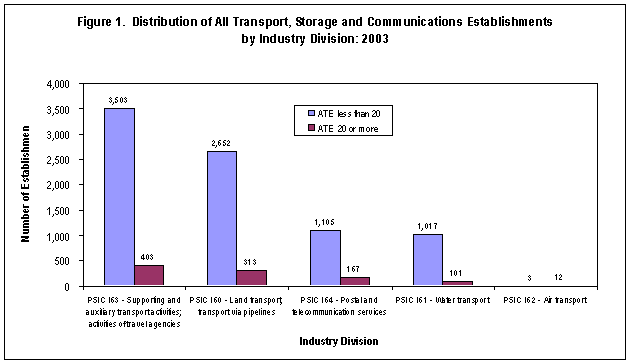
-
Supporting and auxiliary transport activities; activities of travel agencies (PSIC I63), contributed largely to the total establishments with 42.1 percent share (3,906 establishments). Air transport (PSIC I62), on the other hand, recorded the lowest proportion to the total establishments with 0.2 percent (15 establishments).
-
Regional data, for transport storage and communications establishments with ATE of 20 or more, showed that National Capital Region (NCR) registered the highest number of establishments with 551 (55.3%). Central Visayas reported 72 establishments (7.2%). Autonomous Region in Muslim Mindanao (ARMM) and Cordillera Administrative Region (CAR) had the lowest share of 0.3 percent (3 establishments) each. (See Table 4)
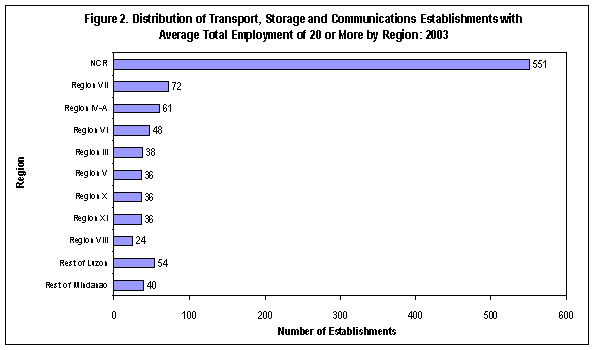
Air transport led all transport industries in terms of average employment per establishment
-
The sector�s total employed persons for 2003 reached 202,751. One-third of the total employment or 67,195 workers were engaged in supporting and auxiliary transport activities; activities of travel agencies (PSIC I63). This was followed by land transport; transport via pipelines (PSIC I60) and postal and telecommunications services (PSIC I64) with 58,313 workers (28.8%) and 49,844 workers (24.6%), respectively.
-
Each transport, storage and communications establishment employed about 22 on the average. Air transport (PSIC I62) had the highest average employment per establishment of 655. Water transport (PSIC I61) had the least with 16 workers per establishment. (See Table R1)
-
Paid employees comprised 95.6 percent of total employed. An estimated 33.3 percent of paid employees were engaged in supporting and auxiliary transport activities; activities of travel agencies (PSIC I63).
-
Transport, storage and communications sector was dominated by male workers in 2003. There were 153,322 males (75.6%) and 49,429 females (24.4%) working in the sector. In terms of sex ratio there are 310 males for every 100 females working in this sector. The land transport; transport via pipelines (PSIC I60) had the highest sex ratio of 904 while postal and telecommunication services (PSIC I64) had the lowest sex ratio of 157. (See Table 1)
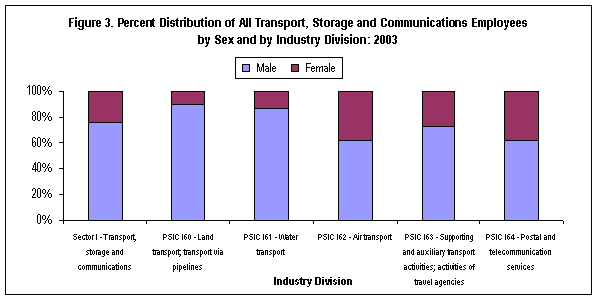
Paid employees in the transport, storage and communications sector received an average monthly compensation of P17,174
-
Total compensation for the year amounted to P39.95 billion, of which 47.8 percent (P19.09 billion) was paid to workers engaged in postal and telecommunications services (PSIC I64).
-
On the average, paid employees in this sector received a monthly compensation of P17,174 in 2003. Air transport (PSIC I62) workers received the highest average monthly compensation of P44,108. Lowest earners were engaged in the land transport; transport via pipelines (PSIC I60) with P7,386.
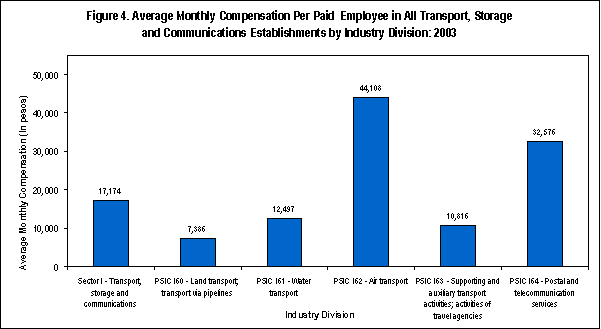
Revenue per peso cost was valued at P1.34
-
Industries that earned larger revenues also spent higher operating costs. Total revenue earned by transport, storage and communications sector was P359.52 billion while the total costs reached P269.14 billion in 2003. For every peso spent, the sector generated as much as P1.34 in revenue.
-
Postal and telecommunications services (PSIC I64) had the biggest proportion to the total revenue and total costs with 58.8 percent (P211.47 billion in revenues) and 59.0 percent (P158.77 billion in costs), respectively.
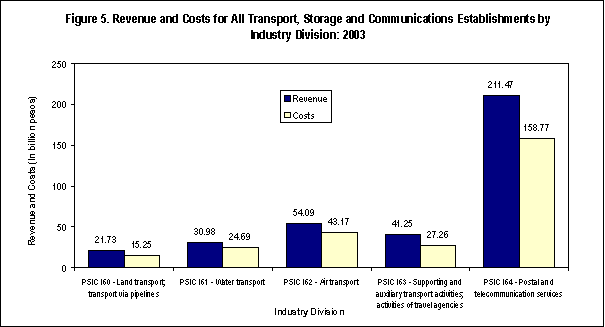
Establishments engaged in postal and telecommunication services recorded labor productivity at P2.97 million
-
Value added was estimated at P204.76 billion. Postal and telecommunication services contributed the biggest share of 70.8 percent or P144.99 billion.
-
Labor Productivity (value added per paid employee) for the transport, storage and communications sector registered at P1.06 million. Two out of five industry divisions that exceeded the national level rate were postal and telecommunications services (PSIC I64) with P2.97 million and air transport (PSIC I62) with P2.27 million.
-
Gross addition to fixed assets amounted to P63.34 billion in 2003. About 78.2 percent or P49.56 billion was acquired by establishments engaged in postal and telecommunication services (PSIC I64).
-
All industries displayed a negative change in inventories except for land transport; transport via pipelines (PSIC I60) with P60.25 million.
-
Subsidies received by the sector was valued at P14.90 billion. Land transport; transport via pipelines (PSIC I60) recorded the highest share of P7.78 billion or 52.2 percent. This was followed by postal and telecommunication services with P7.08 billion or 47.5 percent.
TECHNICAL NOTES
Scope and Coverage
The 2003 Annual Survey of Philippine Business and Industry (ASPBI) was conducted to collect information on the structure and trends of economic activities in the entire country for the year 2003. Covered were establishments engaged in economic activities as defined under the 1994 Philippine Standard Industrial Classification (PSIC). These establishments were classified into 14 sectors, one of which is on Transport, storage and communications (Sector I). The sector is composed of establishments engaged in five industry divisions, namely, land transport; transport via pipelines (I60); water transport (I61); air transport (I62); supporting and auxiliary transport activities; activities of travel agencies (I63); postal and telecommunications services (I64).
All transport, storage and communications establishments nationwide with average total employment (ATE) of 200 and over were covered on a 100 percent basis and those with ATE less than 200 were selected using simple random sampling.
Response
A total of 964 or 90.77% responded out of the 1,062 samples drawn for the sector. Adjustments for non-response were made through imputations.
Concepts and Definition of terms
Establishment is an economic unit, which engages under a single ownership or control, i.e. under a single legal entity, in one, or predominantly one kind of economic activity at a single fixed location.
Economic activity or business is the activity of the establishment as classified under the1994 Philippine Standard Industrial Classification (PSIC). The main activity refers to the activity that contributes the biggest or major portion of the gross income or revenue of the establishment.
Total Employment is the number of persons who worked in or for the establishment as of November 15, 2003.
Paid employees are all persons working in the establishments receiving pay as well as those working away from the establishment when paid by and under the control of the establishment. Included are persons working as full-time or part-time and those employees on sick leave or maternity leave, paid vacation or holiday. Excluded are consultants, home workers and workers receiving commission only.
Unpaid workers include working owners who do not receive regular pay, apprentices and learners without regular pay, and persons working without regular pay for at least one third of the working time normal to the establishment.
Salaries and wages are payments in cash or in kind, prior to deduction for employee�s contribution to SSS/GSIS, withholding tax, etc. Included are total basic pay, vacation, sick, maternity leave pay, overtime pay, and other benefits.
Revenue refers to cash received and receivables for goods sold and services rendered.
Cost refers to all expenses excluding compensation incurred during the year whether paid or payable. Valuation should be at market price including taxes and other charges, net of discounts, rebates, returns and allowances. Goods received from and services rendered by other establishment of the same enterprise are valued as though purchased
Gross additions to fixed assets refer to the cost of acquisition of fixed assets acquired in 2003 less the value of sales of fixed assets during the year.
Fixed assets are physical assets expected to have productive life of more than one year and intended for use and/or being used by the establishment. Included are land, buildings, fixtures, machinery, tool, furniture, office equipment, vehicles, and the like.
Capital expenditures refer to the cost of acquisition of fixed assets acquired in 2003 whether or not full payments have been made.
Subsidies are special grants in the form of financial assistance or tax exemption or tax privilege given by the government to develop an industry or production and to protect it against competition.
Inventories refer to stocks of goods owned by or under the control of the establishment as of a fixed date, regardless of where the stocks are located. Valuation should be at current replacement cost in purchaser�s price at the indicated dates. Replacement cost is the cost of an item in terms of its present price rather than its original price.
Change in Inventories as a derived indicator is computed as the value of ending inventory less the value of beginning inventory.
Value Added is the total revenue plus capital expenditures (own account) plus change in inventories less total cost (net of indirect taxes and interest).
Source: National Statistics Office
Manila, Philippines
-
